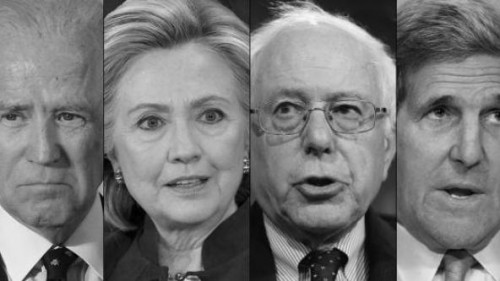Leftwingers’ taunts in 2008 and 2012 have come back to haunt them.

Photo via NRO
In the jubilation of the Obama election victories of 2008 and 2012, the Left warned Republicans that the party of McCain and Romney was now “too old, too white, too male — and too few.” Columnists between 2008 and 2012 ad nauseam berated Republicans on the grounds that their national candidates “no longer looked like America.” The New York Times stable crowed that the Republicans of 2008 were “all white and nearly all male” — not too long before McCain chose Sarah Palin as his running-mate. In reaction to the defeats of McCain and Romney, Salon and Harper’s ran stories on the “Grand Old White Party” and “Angry White Men.”
For Democratic progressives, Hawaiian Barack Obama could not be of mixed ancestry and decidedly middle class, but simply “black” or “African American” — as if he had shared the Jim Crow experience of Clarence Thomas. Nor was there any allowance that race itself had become hard to sort into neat categories in a nation of immigration, intermarriage, and assimilation, in which millions of Americans were one-half this and one-quarter that. Rachel Dolezal and Shaun King proved that well enough by successfully constructing themselves as white for quite a long time.
Liberals had reversed the vision of Martin Luther King Jr.: The color of our skin, not the content of our character, is what matters. Superficial appearance, the ossified politics of the tribe — the curse of the world outside the United States, where corpses have piled up in the Balkans, Rwanda, and Iraq — alone mattered. Identity politics dictated that a shrinking white insular conservative party lacked the Democrats’ “inclusiveness” and “commitment to diversity.” Icons like Barack Obama were what mattered.
So we come to 2016, and the Democrats, of all people, are suddenly in danger of being the washer calling the dryer white. Who exactly are the serious and not so serious presidential candidates of each party?
On the Republican side, there is plenty of diversity as defined by liberals — Ben Carson, Carly Fiorina, Bobby Jindal, Ted Cruz, Marco Rubio.
And on the Democratic side? The only representative of “diversity” is Hillary Clinton, who counts by virtue of being female, but who is white and soon to be 68, a fixture on the national political scene for more than a quarter of a century. Her claim on the nomination seems to be that it’s “her turn,” as if Democrats in the post-Obama era nominate their candidates on the basis of seniority and waiting patiently in line. Her status and connections are apparently seen as exempting her from the consequences of violating federal laws that apply to other public servants.
Her opponent is, in traditional liberal parlance, an old white guy and equally a political fixture, the 73-year-old socialist Bernie Sanders, independent senator from Vermont, who has been running for or holding some office for the last 40 years.
What happens if the Democrats cannot choose between an avowed socialist who is not registered in the party whose nomination he seeks, and Hillary Clinton, who has a felony-indictment sword of Damocles over her head?
It is said that perhaps Secretary of State John Kerry might run, a 71-year-old white guy who has done nothing but politics for the last 30-plus years. He followed Clinton as secretary of state, so why not also as presidential candidate? But if Kerry’s loss in the 2004 presidential race, or his ponderous and pontificating style, still grate on Democrats, there are plenty of other old white guys who could step up.
Al Gore is sometimes mentioned, a 67-year-old white male and former Washington insider. But if Gore’s propensity for occasional hysterics and his multimillion-dollar green hypocrisies are a problem, the Democrats can turn to 72-year-old white guy Vice President Joe Biden. Biden has been a Washington fixer who has done nothing outside of politics for the last 40 years.
If Clinton, Sanders, Gore, and Biden are seen in liberal lingo as “too white and too old” — and if 77-year-old white guy Jerry Brown does not jump into the race, as is sometimes rumored — then the party can turn to one of two other white-guy candidates: 52-year old Martin O’Malley or 69-year-old Jim Webb. Or perhaps Al Sharpton could revive his presidential ambitions?
In fact, so far, the monotonous sameness of the serious and semi-serious Democratic contenders is multifaceted and eerie. Almost all come from the same narrow geographical corridor — Delaware, Maryland, Massachusetts, Vermont, Virginia, and Washington, D.C. Their motto in the 21st century seems to be “Stay east, old man.” Maybe they are channeling the much-caricatured Founding Fathers, the old-white-guy elites from the Eastern Seaboard who governed a mostly white country.
So far, on the list of declared or likely Democratic candidates, there is not a Texan, Louisianan, or Californian among them.
Many also are presidential-candidate retreads. Gore failed to win the 2000 presidential election. Kerry failed to win the 2004 presidential election. Clinton and Biden both failed to capture the 2008 Democratic nomination. The liberal caricature of Romney in 2012 was that he was an old-white-guy has-been — yet again running for office.
But perhaps Democrats define true diversity by both race and class, as in the 2012 tarring of Romney as an out-of-touch 1-percenter, who hated the “47 percent” and did not deign to have coffee with his minority garbage man. Do we remember poor John McCain, who, liberal late-night-talk-show hosts joked, could not remember just how many houses he and his multimillionaire wife actually owned?
The Clinton team may be worth over $200 million — a staggering figure for lifelong public servants. But they discovered a brilliant strategy for quid-pro-quo speaking and shakedown consulting — channeling pay-to-play donations through a foundation. The latter’s major expense was jetting the pair around and paying their unemployed functionaries between election cycles.
Al Gore may be even wealthier. How does a lifelong politician become astronomically rich? In good Marcus Licinius Crassus style, he hyped the fires of climate change and then offered his own brand of fire-extinguishers to put them out: various green videos, speeches, learning packets, schoolbooks, etc. Gore, the advocate of eliminating the internal-combustion engine, made a killing by selling a bankrupt cable station to the carbon-rich and oil-exporting Qatar-owned Al Jazeera, which spews anti-Semitic hate over the air waves. Gore the tax-raiser, who sees more taxes on the wealthy as the fuel that runs necessary redistributionist big government, rushed to cement the Al Jazeera deal in time to beat anticipated Obama-administration hikes in capital-gains taxes.
There is no need to mention the lack of financial diversity of John Kerry. He was married once to a multimillionaire heiress, divorced her, and is now married to the billionaire widow of the late Republican senator John Heinz.
Bernie Sanders is a man of his word: His own relative financial modesty matches his equality-of-results rhetoric.
Is there any diversity to be found?
Isn’t Hillary the feminist candidate — who, unlike vice-presidential candidate Sarah Palin, for liberals really counts as a female, because of her progressive credentials? Perhaps. But by the usual feminist definition of a properly liberated woman, Clinton is found wanting. Without her marriage to Bill Clinton, there would be no political career for Hillary Clinton. Early on, she hitched her star to the politically talented though often dissolute Bill Clinton. In good stand-by-your-man style, she dug in during his serial womanizing, impeachment, and lawsuits by aggrieved former female liaisons, many of whom, in speaking-truth-to-power fashion, claimed that Clinton’s advances were forced and manipulative. For the 2016 race, such devotion apparently has finally paid off.
We live in strange times, with r-trilling local newswomen and the fake ethnic fides of the Ward Churchills, Elizabeth Warrens, Shaun Kings, and Rachel Dolezals, who claim fabricated minority identities for the sake of career advantage and leftwing politics — and in accord with the postmodern idea that we can construct ourselves into any gender or race we wish. Being “minority,” supposedly subject to long-held bias by white, privileged Americans, can mean being an impoverished illiterate newly arrived from Mexico, or it can mean being a third-generation Portuguese American, without fluency in any Latinate language and with no firsthand knowledge of the grandparents’ homeland — or being a middle-class Hawaiian prep-schooler whose exotic nomenclature was reclaimed when it proved advantageous in adulthood.
Nevertheless, this is the bizarre world of identity politics that the progressive movement wanted. These are the rules that they imposed on the nation when a legion of Barack Obamas was announced as America’s future and that of the pace-setting Democratic party. Thus, by their own illiberal standards, they stand convicted of illiberality.
For the present gang of 2016 Democratic presidential hopefuls, leftwing politics demands no penance for being “too old and too white.”



